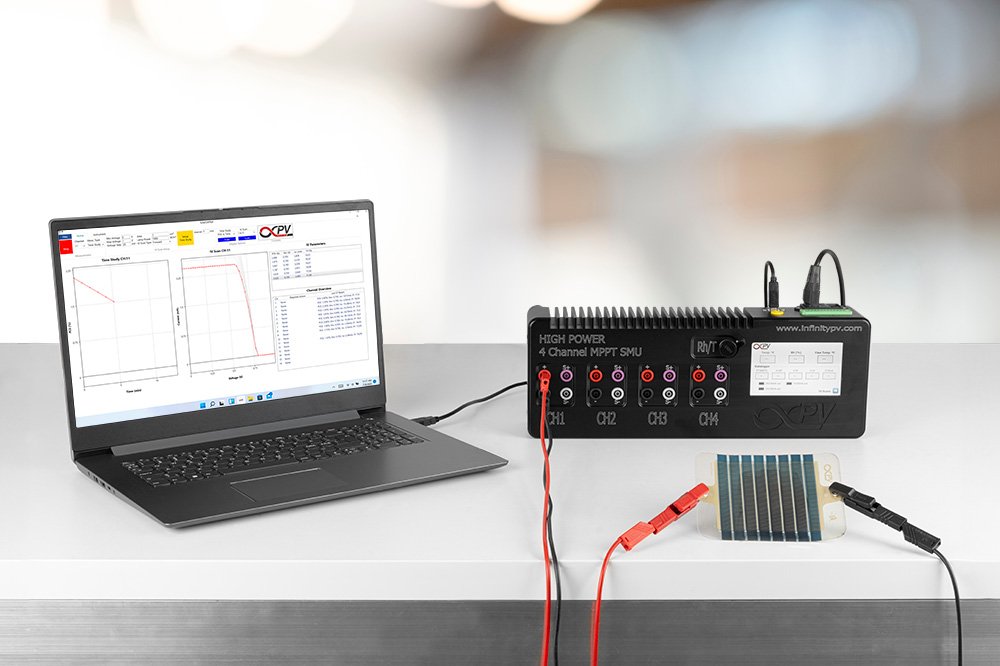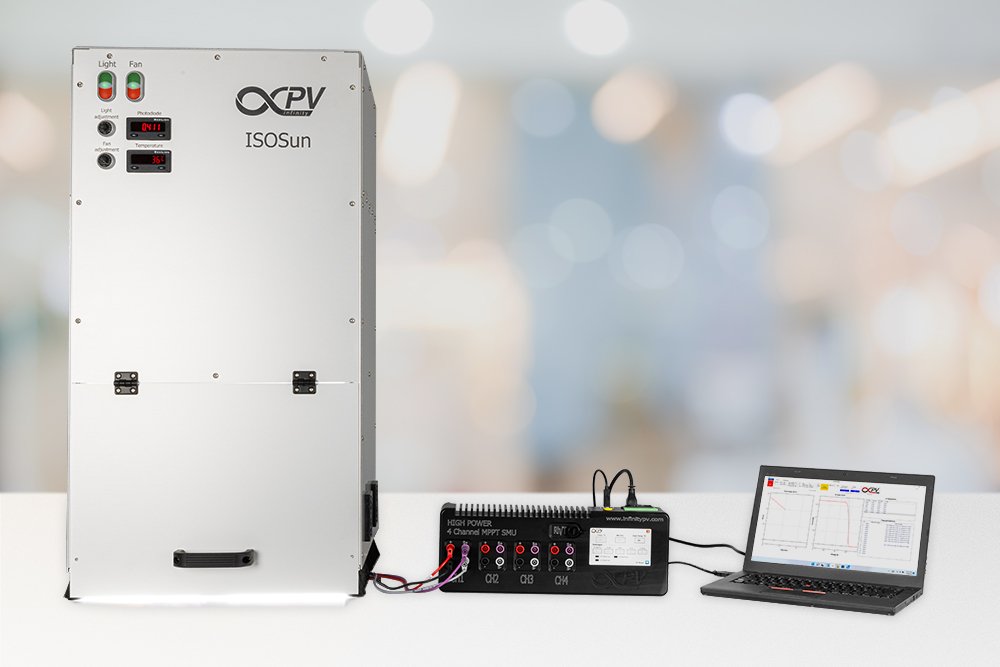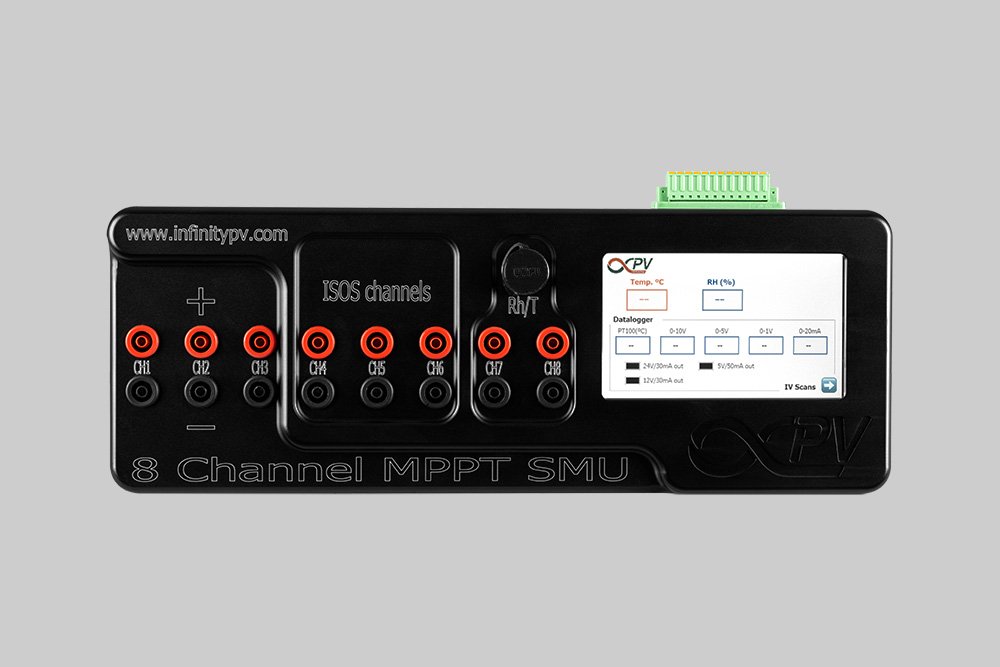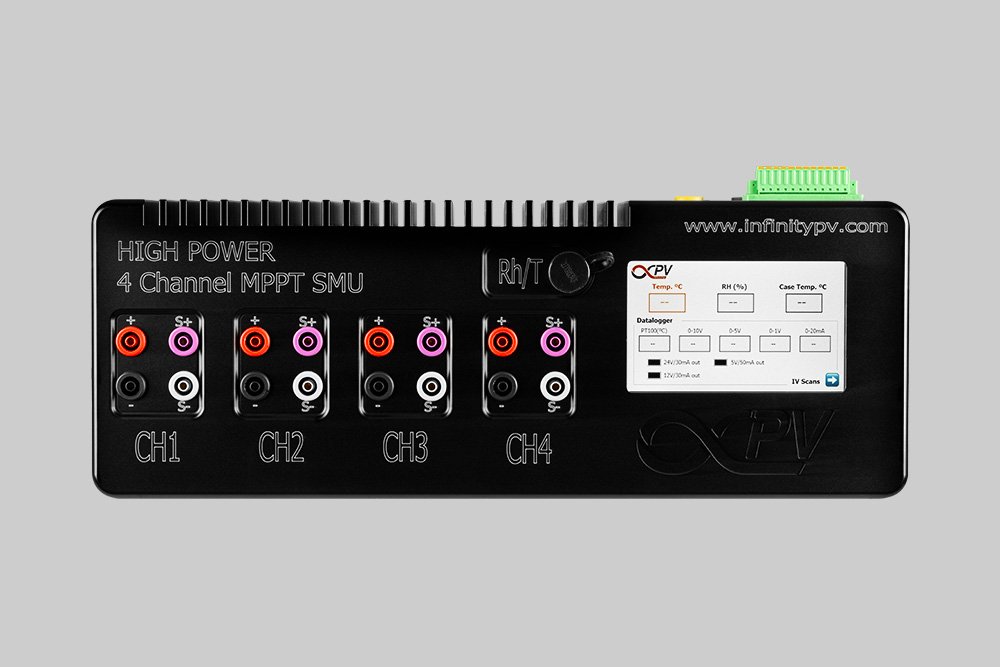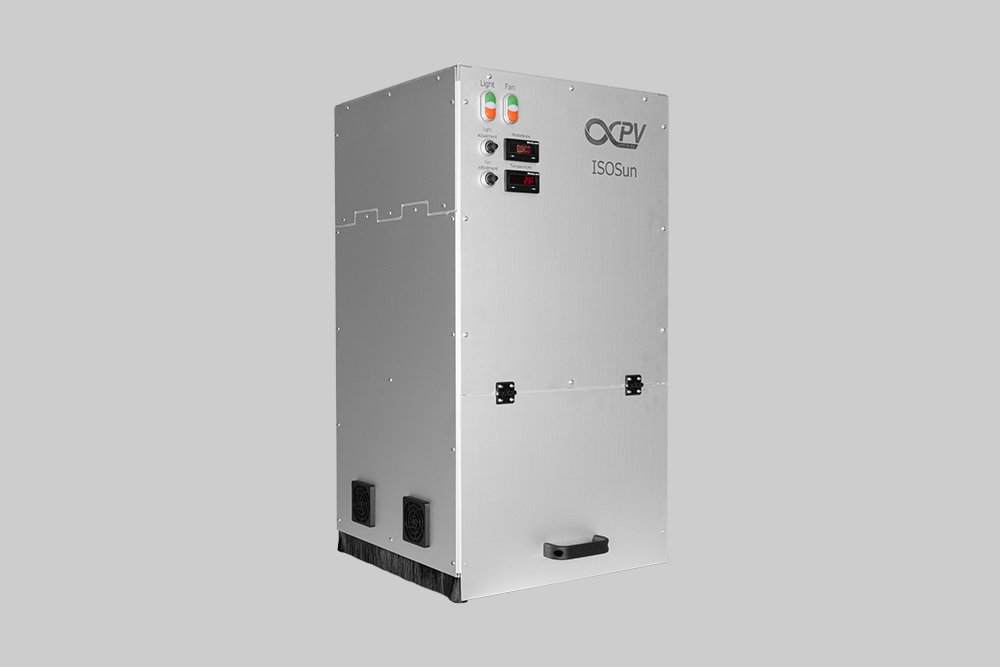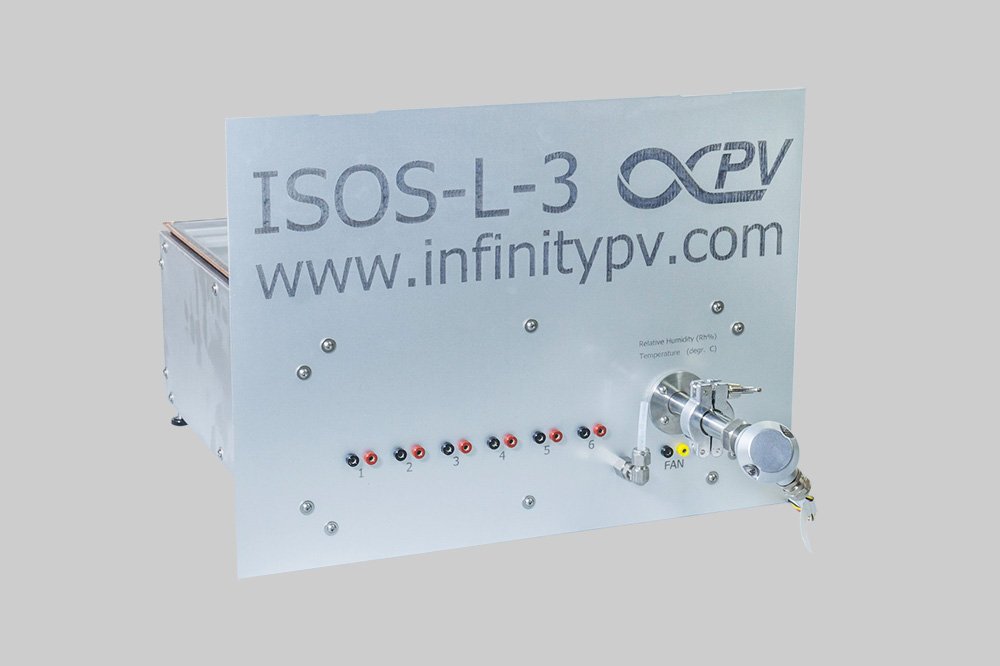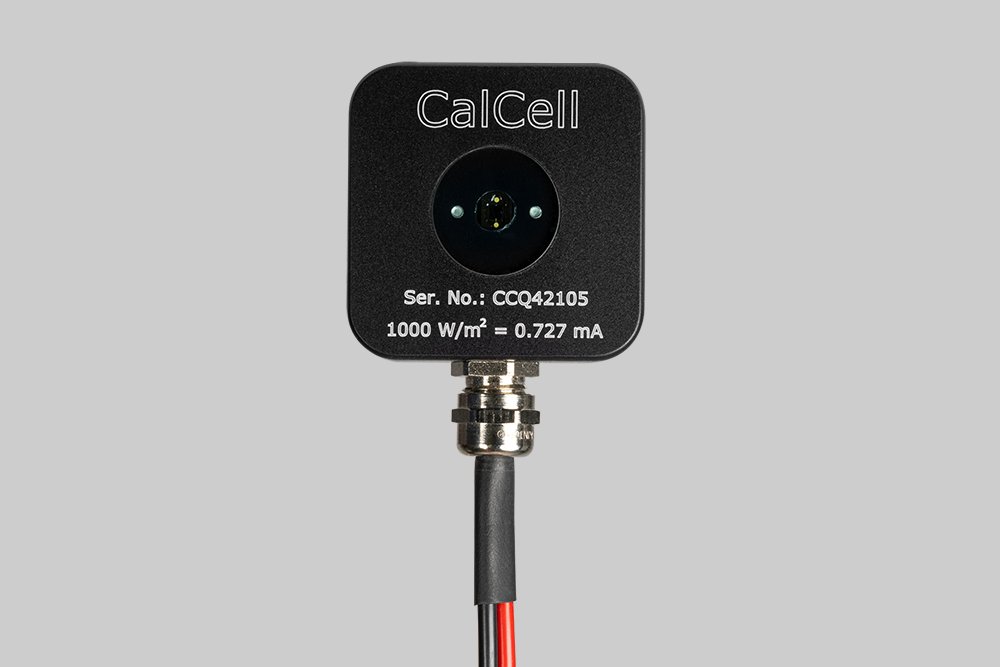Understanding Maximum Power Point Tracking (MPPT) and IV Curve Analysis for Solar Cell Characterization
The IV and Lifetime software controls and collects data from Source Measure Units (SMU) for solar cell characterization and lifetime studies
With the growing emphasis on renewable energy sources, solar power has become one of the most significant contributors to a sustainable energy future. Solar cells, or photovoltaic (PV) cells, convert sunlight directly into electricity. However, the performance of these cells varies under different conditions, influenced by factors such as temperature, sunlight intensity, and shading, but is also depending on the stability of the cell, which is a crucial factor that affects the technology’s commercial viability. Understanding and optimizing the stability of solar cells is paramount for the future development of emerging solar cell technologies, like organic, perovskite, quantum dot-based and dye-sensitized.
In the characterization of laboratory-scale solar devices, it is essential to employ accurate and effective methodologies to ensure optimal performance analysis and efficiency assessment and here Maximum Power Point Tracking (MPPT) plays a crucial role. Besides MPPT, Current-Voltage (IV) curve analysis is also readily used for characterization of solar cells produced in laboratories. Both methods provide unique insights and serves different purposes in the characterization of solar cells.
What is Maximum Power Point Tracking (MPPT)?
MPPT is an electronic system used in solar inverters which optimizes the power output from solar panels by continually adjusting the electrical operating point of the modules. In essence, every solar panel operates most efficiently at a specific combination of voltage and current known as the Maximum Power Point (MPP). By dynamically adjusting input operating conditions, MPPT systems ensure that solar arrays are always delivering maximum power under varying environmental conditions. Figure 1 illustrates an IV curve of a solar cell and the resulting power curve (P= I x V). The power curve shows a maximum Pₘₐₓ for a given set of Iₘₚ and Vₘₚ which defines the MPP on the IV curve.
Figure 1: Power as a function of IV
Open-Circuit Voltage (Vₒ꜀): The maximum voltage available from a solar cell when no current is flowing.
Short-Circuit Current (Iₛ꜀): The maximum current output when the voltage is zero (the cell is shorted).
Maximum Power Point (MPP): The point on the IV curve (Vmp x Imp) where the product of current and voltage is maximized, representing the cell's optimal power output.
Maximum Power Output (MP or Pₘₐₓ): The power obtainable when operating a solar cell at MPP.
Fill Factor (FF): A parameter that describes the shape of the IV curve and indicates the quality of the solar cell; it is defined as the ratio of the maximum power point to the product of Vₒ꜀ and Iₛ꜀.
AKIO TV: MPPT explained (AKIO TV)
Why Is It Important to Use MPPT Tracking When Studying Solar Cell Stability?
The short answer to this is: because this is the real life conditions a solar cell will operate under when put to power production and is therefore the most realistic way of evaluating the stability of a solar cell. Digging a little deeper into the potential consequences of not using MPPT when studying solar cell stability, it is necessary to look at what the solar cell “experiences” in various scenarios.
The solar cells are connected to a Source Measure Unit (SMU) - MPPT Tracker and placed inside a solar simulator .IV and Lifetime software is used to control the Source Measure Unit and collect data.
Open circuit: If the solar cell is left without any connection (open circuit), it experiences the highest possible voltage it can generate on its own – but no current is running through the cell. Degradation mechanisms originating in a large potential difference over the solar cell are enhanced by conducting a study in open circuit, whereas effects due to currents will be minimized.
Short circuit: When kept in short circuit a solar cell is putting out the maximum possible current it can produce – but it experiences no voltage differences between the electrodes. We thus have the opposite situation of open circuit, and degradation effect related to high current will be enhanced whereas effects related to potential differences are minimized.
MPPT: When conducting a stability study under realistic conditions both effects originating in a current through the cell and the presence of potential differences will affect the solar cell.
With the Slot-die Coater, it is easy to make solar cells.
How to Determine and Monitor Maximum Power Point for Solar Cells
A way to determine the MPP is to run an IV curve of the solar cell as shown in Figure 1. However, some solar cell materials, like perovskites, have proved to be prone to changes in behavior if the solar cells are exposed to voltage changes. Running a traditional IV curve will in such cases be directly counterproductive, as the measurement will be a cause of degradation. It is therefore important to find the right method to obtain the MPP.
Most Common MPPT Algorithms to Maximize Solar Cell Power Output
Several algorithms have been developed to implement MPPT. Below are some of the most common:
Perturb and Observe (P&O): This method involves perturbing the operating voltage and observing the change in power. If the power increases due to the perturbation, the system continues in that direction; if it decreases, the direction is reversed.
Incremental Conductance (IncCond): This algorithm calculates the derivative of power with respect to voltage to find the MPP. It compares the incremental conductance with the instantaneous conductance to adjust the voltage appropriately.
Constant Voltage (CV): This is a simpler method where the voltage is maintained at a fixed level, often set at the point where the maximum power is observed under standard test conditions.
Fuzzy Logic Control: Combining fuzzy logic with MPPT can enhance the adaptability of the system in unpredictable conditions by mimicking human reasoning in decision-making processes.
Neural Networks: Using artificial intelligence techniques, neural network-based MPPT aims to predict the MPP based on past performance and current conditions, providing a robust tracking mechanism.
Comparison of MPPT Tracking and IV Curves for Characterization of Laboratory Scale Devices
| Aspect | IV Curves | MPPT |
|---|---|---|
| Purpose | To assess the performance and efficiency of solar cells through static measurements. Provides a comprehensive view of how a solar cell behaves under different conditions. | To optimize power output in real-time by dynamically adjusting voltage and current to maintain operation at the maximum power point. |
| Measurement Method | Involves measuring current output at various voltage levels, typically under controlled conditions. | Utilizes algorithms to iteratively adjust and monitor output to continuously find the maximum power point. |
| Information Provided | Provides detailed information about a solar cell's characteristics - including Iₛ꜀, Vₒ꜀, FF, and Pₘₐₓ. | Provides real-time efficiency and output performance data, ensuring maximum energy capture from solar panels during operation. |
| Data Representation | Visualized as a curve plot, showing the relationship between current and voltage. | Typically represented by the power output efficiency over time or under different environmental conditions (e.g., sunlight intensity changes). |
| Applications | Used primarily in characterization tests, research applications, and quality assessments during manufacturing. | Used in solar energy systems and inverters for optimizing energy production and real-time monitoring. |
| Complexity | Less complex; requires basic measurement instruments (multimeters, data loggers). | More complex due to the requirement of algorithms and circuitry for real-time adjustments. |
| Limitations | Static analysis, does not provide real-time performance insight during variable conditions. | Real-time response dependent on algorithm effectiveness and may struggle under rapidly changing conditions. |
Advantages and Limitations of IV Curve and MPPT
As is hopefully clear from the above the optimal choice of characterization method for a solar cell, very much depends on what information is desired – and to some degree, what conditions a specific type of solar cell can sustain. Below are listed some of the pros and cons of IV and MPPT characterization.
IV Curve Advantages:
Comprehensive Characterization: IV curve analysis provides a full profile of a solar cell’s performance, yielding crucial information about its behaviour under varied conditions.
Quality Assessment: It helps in assessing manufacturing quality and identifying defects in solar cells.
Standardized Testing: IV curves can be drawn under standard conditions which allow for consistency in measurement comparison.
IV Curve Limitations:
Static Data: It does not reflect the dynamic behaviour of the solar cell under real-time variable operating conditions, which is crucial for actual energy generation.
Time-Consuming: Generating IV curves, particularly in detailed analysis setups, can take significant time.
Potential damage: for some materials, like perovskites, the applied sweep of voltage can potentially induce degradation of the solar cell.
MPPT Advantages:
Optimization: MPPT ensures that solar cells operate at their maximum efficiency.
Real-Time Performance: It adapts continuously to changing conditions, maximizing output throughout the day.
Reliable Energy Conversion: Incorporates real-time data.
Gentle: For voltage sensitive materials like perovskites, this is a gentler method of monitoring.
MPPT Limitations:
Implementation Complexity: Requires complex algorithms and technology that may increase system costs.
Dependence on Algorithm: Performance can vary based on the chosen MPPT algorithm, potentially leading to non-optimal tracking under fluctuating conditions.
Conclusion
The advancement and optimization of solar cell technology are crucial for the sustainable energy future we strive towards. Accurate characterization of solar cells, through methods like Maximum Power Point Tracking (MPPT) and Current-Voltage (IV) curve analysis, plays a pivotal role in assessing and improving their performance. MPPT, by dynamically adjusting operational parameters to maximize power output under real-world conditions, offers a realistic evaluation of solar cell stability and efficiency. Conversely, IV curve analysis provides a comprehensive view of solar cell characteristics but lacks real-time adaptability. Each method has its distinct advantages and limitations, and their application depends on the specific information needed and the operational conditions of the solar cells. By integrating both MPPT and IV curve analysis into research and development practices, we can better understand and enhance solar cell technologies, paving the way for more efficient and reliable solar energy solutions.
More About Maximum Power Point Tracking
Articles
Wang, Yanbo, Xiao Liu, Zhongmin Zhou, Pengbin Ru, Han Chen, Xudong Yang, and Liyuan Han. "Reliable Measurement of Perovskite Solar Cells." Advanced Energy Materials, vol. 9, no. 14, 2019, p. 1900123. https://doi.org/10.1002/aenm.201900123
Ahmad, Fahad Faraz, Chaouki Ghenai, and Maamar Bettayeb. "Maximum Power Point Tracking and Photovoltaic Energy Harvesting for Internet of Things: A Comprehensive Review." Renewable and Sustainable Energy Reviews, vol. 146, 2021, p. 111176. https://doi.org/10.1016/j.rser.2021.111176
Baba, Ali Omar, Guangyu Liu, and Xiaohui Chen. "Classification and Evaluation Review of Maximum Power Point Tracking Methods." Sustainable Futures, vol. 2, 2020, 100020. ISSN 2666-1888. https://doi.org/10.1016/j.sftr.2020.100020
Video
MPPT explained (AKIO TV) (MPPT stands for maximum power point tracking, which is often used to increase the production of variable power sources, like solar panels or wind turbines. In this video, we'll take a look at what it is.)

